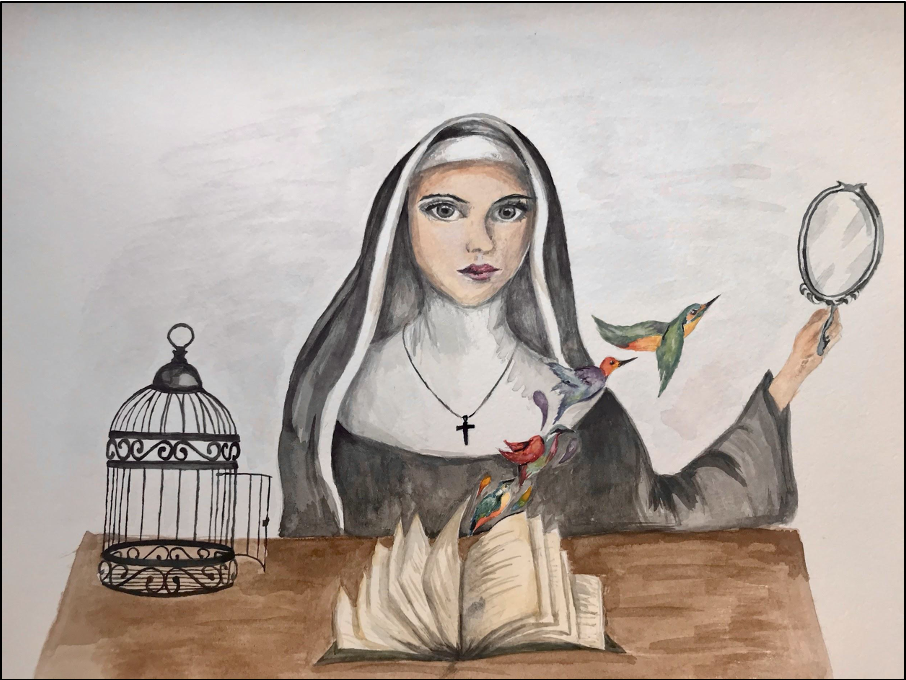Oxford first-year Spanish students have taken the opportunity to respond creatively through the visual arts and creative writing to some of the literary works they had studied earlier in the year, or works they plan to study next year. We saw one project last week. Here are samples from three more.
Josh Aruliah (Spanish and Linguistics, Keble College)

“This drawing depicts my interpretation of Jorge Luis Borges’s ‘Library of Babel’, which is a hypothetical library that consists of an indefinite number of identical hexagonal galleries and contains every possible book that could be written (up to a certain length). I featured illusions, drawing inspiration from the work of Dutch artist M. C. Escher, to convey the impossible and bewildering nature of the library; the staircase and the railings are inconsistent and demonstrate the lack of a fixed direction of gravity. It is not a literal depiction of the library as I aimed instead to portray the perplexing experience of trying to visualise Borges’s fascinating creation. The short story reveals that almost all of the books contain complete gibberish and, therefore, the librarians seem to be condemned to an eternal and vain search for meaning. There is little distinction between the books and galleries in the drawing, with the upper gallery perhaps giving the impression of a reflection, which demonstrates this idea of endless futility.”
Darcie Dorkins (History and Spanish, Exeter College)

“I chose to paint Sor Juana Inés de la Cruz, one of the most important figures of Spanish colonial literature, whose works were widely acclaimed during her lifetime and continue to be celebrated today. I was inspired to visually explore the conflicting notions of restriction and freedom in Sor Juana’s life which stemmed from her overlapping roles as a nun, woman, and outstanding writer, with a particular focus on one of her most widely read poems, ‘Hombres necios’. Thought to have been written in around 1680, I felt that the poem was a valuable representation of the precarious space she occupied between contemporary religious, intellectual and literary spheres in both her native Mexico and in Spain, where her works were also popular. To this end, I aimed to incorporate various symbolic elements within the piece: Sor Juana herself, as the subject of many striking portraits; the visual prominence of religion, a defining feature of her life with considerable implications for her literary career; and a book, to represent her extensive learning. I also included a mirror, as in ‘Hombres necios’ Sor Juana symbolically confronts men with the realities of their irrational and impossible standards for women, along with birds and an open cage to reflect the issues of restriction and liberation in her life.”
Darcie also translated the closing lines of Sor Juana’s Primero sueño (First Dream), a notoriously complex and linguistically rich poem:
Llegó, en efecto, el sol cerrando el giro
que esculpió de oro sobre azul zafiro.
De mil multiplicados
mil veces puntos, flujos mil dorados,
líneas, digo, de luz clara, salían
de su circunferencia luminosa,
pautando al cielo la cerúlea plana;
y a la que antes funesta fue tirana
de su imperio, atropadas embestían:
que sin concierto huyendo presurosa,
en sus mismos horrores tropezando
su sombra iba pisando,
y llegar al ocaso pretendía
con el sin orden ya, desbaratado
ejército de sombras, acosado
de la luz que el alcance le seguía.
Consiguió, al fin, la vista del ocaso
el fugitivo paso,
y en su mismo despeño recobrada,
esforzando el aliento en la ruïna,
en la mitad del globo que ha dejado
el sol desamparada,
segunda vez rebelde, determina
mirarse coronada,
mientras nuestro hemisferio la dorada
ilustraba del sol madeja hermosa,
que con luz judiciosa
de orden distributivo, repartiendo
a las cosas visibles sus colores
iba, y restituyendo
entera a los sentidos exteriores
su operación, quedando a luz más cierta
el mundo iluminado, y yo despierta.
And sure enough, the Sun arrived, sealing the orbit
it etched in gold upon the sapphire blue sky.
Born of a thousand
times thousand points, a thousand golden streams,
and lines, I say, of pure light, which radiated
from its luminous circumference,
marking the sky-blue page;
and, converging, they charged towards
that former sepulchral tyrant of their empire,
who, stumbling over her own horrors,
treading on her own shadow,
erratically with haste, trying to reach the West
with her now confused, disorderly
army of shadows, pursued
by the light following closely behind.
At last, that fugitive retreat
gained sight of the West,
and, recovering from her downfall,
steeling her crushed spirit,
rebellious for a second time,
she resolves to see herself crowned
in that half of the globe that
the Sun has left unprotected;
meanwhile, the golden tresses of the Sun
beautified our hemisphere,
and with judicious light
and ordered generosity reimbursed
all visible things with their colours,
and restored the external senses their full
operation, leaving the world illuminated
by a more certain light, and I awake.
